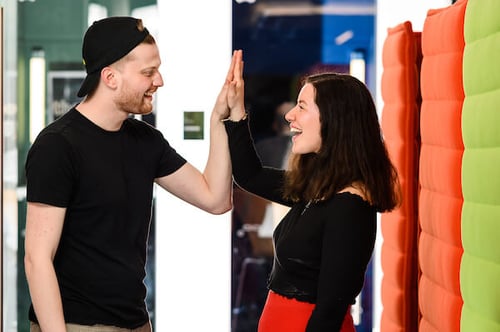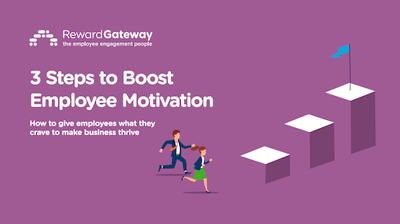
7 min read
Some people are born to recognize. We know that some people find recognition really natural — they love giving it, and they love receiving it. But that’s not always the case.
Just because recognition isn't natural to someone doesn't mean they're not an effective, inspiring leader.
Sometimes we need to invite them to participate a little differently than those people who were born recognizing. They might need a little nudge, or they might be an all-out skeptic, believing that “recognition just doesn’t work.”
After training thousands of managers, in all industries at companies of all sizes, I’m no stranger to the skeptic in the room. But what I’ve found is that the root of their skepticism typically resides in three main factors.
The employee recognition dilemma, according to the skeptic:
| 1. They don’t think daily actions are worthy, so they don’t recognize |
| 2. They think recognition isn’t genuine, so why bother? |
| 3. They don’t believe it actually does anything, so they need to see the impact |
Dilemma One: Skeptics don’t think daily actions are worthy, so they ignore recognition entirely
Improving your team’s performance is a focus for all managers, and inevitably there are some on each team that just “get it” – they’re more consistent at using it than others. As we ask managers to use recognition as a tool, this can lead to challenges, like the perception of favoritism in employee recognition.
While employee recognition is known to improve team performance, the absence of recognition can actually cause friction points for employees.
The most important thing about recognition, arguably, is that it’s consistent. The power of recognition doesn't drive organizational results if three managers are recognizing and the rest of the people are not.
The true turnaround comes when that skeptic starts to see the actual intent of what you, the recognizer, is trying to do by recognizing simple, but important, actions. And you can do that through strategic recognition, which you can embed via a three-step process.
Here’s something I hear all the time: “I’m not going to recognize them for just showing up. They need to go above and beyond.” While going above and beyond is important, without appreciation, less people will be willing to go the extra mile for you. Think about those aspects of the job that are done less consistently. Like, cross-selling of products, or handling a frustrated customer with empathy, or taking initiative to solve a problem.
We don’t want people to recognize so much that it becomes trite or boring. But what we can do is work with managers to find out what are the parts of the job that you’d like to see done more or better?
That’s where you can turn a skeptic into a believer.
Being strategic about recognizing keeps these stories powerful and exciting. Here’s what we’ve found works best:
| Three steps to strategic recognition: |
| Step one: Tell the action |
| Step two: Connect to an area of focus or company value |
| Step three: Explain the impact |
First, sharing moments of recognition gives others insight into what is happening in other departments. This is why we want to share it because as you share that recognition, people go, "Oh, I forgot that our values are rolling out. I can't wait to hear about it." It stops the eye rollers in their tracks.
They see that impact, in knowing what is going on in other areas of the business. They think, “I wish people knew what my team was doing.” Guess what? They can, if they took the minutes out of their day to share a moment of recognition for someone on their team.
This automatically makes your recognition more genuine as well. If you keep a focus on making recognition genuine, it feels less likely to be interpreted as favoritism. What do I mean by that? Here’s an example:
.png?width=500&name=ecard-skeptics%20(1).png)
The impact on the action is very clear. The reader (that eye roller!) will understand why you recognized, and see how it made a difference in your day.
Dilemma Two: Skeptics don’t think recognition is genuine
One thing I’ve noticed is that the skeptics also tend to zero in on whether or not recognition feels “real.” They may resist frequent or written recognition out of concern it will feel forced. Using the three steps I mentioned above helps avoid that concern, since it naturally makes the moment of recognition significant.
This concern about recognition might also lead to managers developing their own practices that feel more meaningful to them (candy giveaways, or hand-written postcards). While these low-cost employee recognition ideas are great to add to the recognition landscape, we don’t recommend having your main method of recognition misaligned with the larger organization.
This sort of recognition isn’t sustainable because we miss out on the great work of other teams, and may begin to feel that our group is different or working harder than others. Finding a way to consistently recognize through a program like eCards or monetary rewards that has clear guidelines makes your employee recognition program sustainable.
If you're going to put the effort into putting a program together and designing it, you want people to use it.
And that’s how you can build and grow a sustainable recognition program. Turning it around for the skeptic, if you have a long-lasting, effective recognition program that’s delivering value, they’ll turn into a believer.
So how do you recognize employees without favoritism? Teach people how to recognize, the right way.

Dilemma Three: Skeptics don’t believe in the business impact of employee recognition
By connecting the story to one of your values or behaviors you want to see, you can further connect your people to helping the business succeed.
Values-based eCards and peer-to-peer recognition programs demonstrate how employees are living the company's values. Many of our clients' recognition programs focus on this, and even use recognition as a way to cross-train behaviors between groups.
It’s also a great way to help others in the business understand what values even are! By linking a recognition program to company values, you can take advantage of a huge opportunity to connect people to something bigger and taller than themselves: Your company’s purpose.
Recognition helps people do more of what you (and your business!) want and need.
For the skeptics, here’s an easy place to start: Think of a business result you care about. Reducing turnover, increasing sales, improving quality. Next, think of the actions that those on your team OR outside your team do to support those actions. Finally, make it your mission to recognize when people take those actions.
You don’t care about doughnuts in the break room to perk people up after a particularly challenging week? Fine. But what do you care about? Every person in the workplace can use help, and there's typically someone (or a team) who makes their jobs easier, more efficient and more enjoyable. Think about it, who helps you be a better employee?
For example, I worked with a hospital and was speaking with a group of surgeons. One in particular was the definition of a skeptic. He was sitting in the back of the room, and said to me something like “I am focused on saving time and being efficient. If people aren’t supporting a quick turnaround in the operating room, I don’t have time to be nice or explain. If I yell, I know they’ll listen.”
.jpg?width=500&name=shutterstock_1297169209%20(1).jpg)
Wrong! I told him, that might feel like it is working in the short-term, but what about long-term. Instead of yelling, try finding the person who does it right and thank them for it. And make sure that recognition is public, so others hear it, or see it (this is where social recognition can help amplify these moments quickly and easily).
So he tried it. And guess what? Through conversations and interactions, he discovered that some of them had just started, and the mistakes he was seeing was because they didn’t really understand his preferences. With a more positive approach he removed misunderstandings, built a team that wanted to be helpful, and saved himself loads of time. This also helped improve employee retention in healthcare, an industry known for high levels of turnover.
By actively recognizing the good behaviors he saw, more and more people noticed, and the standard of care for the patients improved as a result.
If we can get just a little bit better at how we demonstrate gratitude in the workforce, imagine what a better world we would live in. Use these examples to build better relationships at work, with your clients or even your customers — building true business value by changing that skeptic’s mind. And if you’re the skeptic, I hope I’ve done my part in changing your mind about the true value of recognition.




